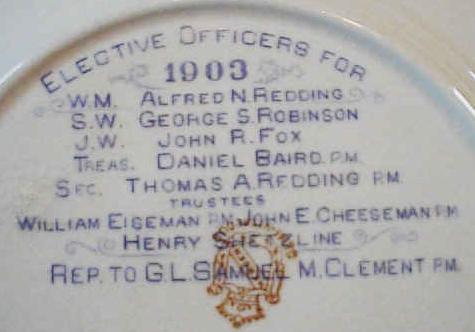|
1903 Melita Lodge
No. 295 Commemorative Plate
Picturing
Independence Hall, Philadelphia, PA


This beautiful flow blue plate pictures
Independence Hall in Philadelphia, Pa. It was made in 1903 for Melita Lodge No. 295
F. & A.M. It names the five principal officers of the Lodge on the reverse, the
trustees, and the representative to the Grand Lodge of Pa. It is in wonderful
condition with some light crazing.
Independence Hall is a U.S.
national landmark located in Philadelphia, Pennsylvania on Chestnut Street
between 5th and 6th Streets. Known primarily as the location where the
Declaration of Independence was debated and adopted, the building was completed
in 1753 as the Pennsylvania State House for the Province of Pennsylvania. It
became the principal meeting place of the Second Continental Congress from 1775
to 1783. The United States Declaration of Independence and United States
Constitution were both signed at Independence Hall. The building is now part of
the larger Independence National Historical Park and listed as a World Heritage
Site.
Independence Hall is a red brick building, built between 1732 and 1753, designed
in the Georgian style by Edmund Woolley and Andrew Hamilton, and built by
Woolley. Its highest point is 135 feet (41 m) above the ground. Its construction
was commissioned by the Pennsylvania colonial legislature and it was initially
inhabited by the colonial government of Pennsylvania as their State House. Two
smaller buildings adjoin Independence Hall: Old City Hall to the east, and
Congress Hall to the west. These three buildings are together on a city block
known as Independence Square, along with Philosophical Hall, the original home
of the American Philosophical Society.
Independence Hall is pictured on the back of the U.S. $100 bill, as well as the
bicentennial Kennedy half dollar. The Assembly Room is pictured on the reverse
of the U.S. two dollar bill, from the original painting by John Trumbull
entitled Declaration of Independence.
The bell tower steeple of Independence Hall was the original home of the
"Liberty Bell" and today it holds a "Centennial Bell" that was created for the
United States Centennial Exposition in 1876. The original Liberty Bell, with its
distinctive crack, is now on display across the street in the Liberty Bell
Center. In 1976 Queen Elizabeth II visited Philadelphia and presented a gift to
the American people of a replica Bicentennial Bell, which was cast in the same
British foundry as the original. This 1976 bell hangs in the modern bell tower
located on 3rd Street near Independence Hall.
From 1775 to 1783, Independence Hall served as the principal meeting place of
the Second Continental Congress, a body of representatives from each of the
thirteen British North American colonies. The United States Declaration of
Independence was approved there on July 4, 1776, and the Declaration was read
aloud to the public in the area now known as Independence Square. This document
unified the colonies in North America who declared themselves independent of the
Kingdom of Great Britain and explained their justifications for doing so. These
historic events are celebrated annually with a national holiday for U.S.
Independence Day.
On June 14, 1775, delegates of the Continental Congress nominated George
Washington as commander of the Continental Army in the Assembly Room of
Independence Hall. The Congress appointed Benjamin Franklin to be the first
Postmaster General of what would later become the United States Post Office
Department on July 26.
a National Park Service Ranger describes Independence Hall's Assembly Room, in
which both the Declaration of Independence and Constitution were drafted and
signed. In September 1777, British Army arrived to occupy Philadelphia,
forcing the Continental Congress to abandon the State House and flee to York,
Pennsylvania, where the Articles of Confederation were approved in November
1777. The Congress returned on July 2, 1778, after the end of the British
occupation. However, as a result of the Pennsylvania Mutiny of 1783, Congress
again moved from Philadelphia in June 1783.
In September 1786, commissioners from five states met in the Annapolis
Convention to discuss adjustments to the Articles of Confederation that would
improve commerce. They invited state representatives to convene in Philadelphia
to discuss improvements to the federal government. After debate, the Congress of
the Confederation endorsed the plan to revise the Articles of Confederation on
February 21, 1787. Twelve states, Rhode Island being the exception, accepted
this invitation and sent delegates to convene in June 1787 at Independence Hall.
The resolution calling the Convention specified its purpose as proposing
amendments to the Articles, but the Convention decided to propose a rewritten
Constitution. The Philadelphia Convention voted to keep deliberations secret,
and to keep the Hall's windows shut throughout the hot summer. The result was
the drafting of a new fundamental government design. On September 17, 1787, the
Constitution was completed, and took effect on March 4, 1789, when the new
Congress met for the first time in New York's Federal Hall.
Article One, Section Eight, of the United States Constitution granted Congress
the authority to create of a federal district to serve as the national capital.
Following the ratification of the Constitution, the Congress, while meeting in
New York, passed the Residence Act of 1790, which established the District of
Columbia as the new federal capital. However, a representative from
Pennsylvania, Robert Morris, did manage to convince Congress to return to
Philadelphia while the new permanent capital was being built. As a result, the
Residence Act also declared Philadelphia to be the temporary capital for a
period of ten years. The Congress moved back into Philadelphia on December 6,
1790 and met at Congress Hall, adjacent to Independence Hall.

|
